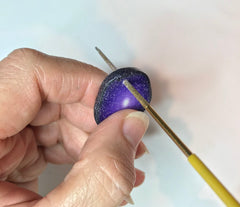
Are diamonds just for rings?
Share

Absolutely not!
There are many uses for diamonds that most people don't know about. For the creative artist, diamonds, or diamond dust, are used on files to make jewelry as well as other crafts where a versatile, and often small filing tool is needed.
Unlike a steel file that has teeth that will cut in only one direction, a diamond file's surface is covered with diamond particles that will cut in any direction. This means they cut material on both the push and pull strokes unlike steel files. Because of this feature they are essential when working in detailed and tight areas.
Diamond files can also be used on many materials that other abrasives won't touch. I first discovered these when working with precious metal clay, silver and brass. They are handy for reshaping glass cabochons and any metal add-ons too. While I mostly work with polymer clay in my current creative endeavors, there are times when the project just calls for a different media so it's a good idea to have a set of diamond files handy in the tool box.
When it comes to working on findings and wires for jewelry a diamond file makes it easier to remove metal burs and clean up rough edges. Note that it is always best to further smooth the metal with a progression of sanding papers to get a smooth finished surface.
In my research I found a variety of things diamond files can be used for but I will highlight some important TIPS I developed for using them in the craft of working with polymer/metal clay. These tips apply to the Diamond Needle Files found in the shop.
LINDA'S 4 TIPS FOR DIAMOND NEEDLE FILES
#1 - Be gentle!
Diamond needle files come in a variety of grits just like sanding paper. The smaller the number the larger the grit - the more material that is taken off, and the rougher the finish. This can provide a subtle texture or a starting place to remove a lot of material to reshape a project. Filing with these diamond files doesn't require a lot of strength. Using a gentle touch will give you more control at achieving the best results. When using these for fired polymer clay I found it best to clean off the filed surface with water to get rid of the filing dust and/or proceed to the next step of refining it with sanding paper.

#2 - Diamond needle files come in a variety of shapes.
One of my favorites is the round. I can't think of a time working with clay that I have't had to smooth or enlarge a punched hole in a project. Because of the unique feature of diamond files, it is a must have for cleaning up burs in holes in fired and/or dry clay. The really cool thing is that the other shapes can be used for the same purpose but with the added option to totally reshape the hole into an oval or triangle or . . . !
Note: that to change the shape you are limited by the size of the file. Start with a smaller hole if you are intending to do this!


#3 - Make a handle for it!
PLUS - since I like to keep my tools handy, I discovered that making a handle with a flat bottom allows the file to stand up on my table ready for me to grab. (I do this for my drill bits also which are shown here.) The smaller ones even fit in a little drawer on my tool caddy!

#4 - ALWAYS clean the file after use!
In order to keep your tools ready to use and prolong their life, always clean them after every project. This is especially true for polymer clay when colors will be left from the fired clay and can transfer to other projects. Using a stiff bristle brush is all that is needed to clean the clay from the file. For most metals this is enough. For polymer clay however it works better and faster to wet the file/brush when cleaning. You won't be sorry you took the time to clean!
Ever since my college days, I have always practiced what my instructors taught me. "Buy the best tools you can afford and keep them clean. You will never have to buy another to replace it."*
